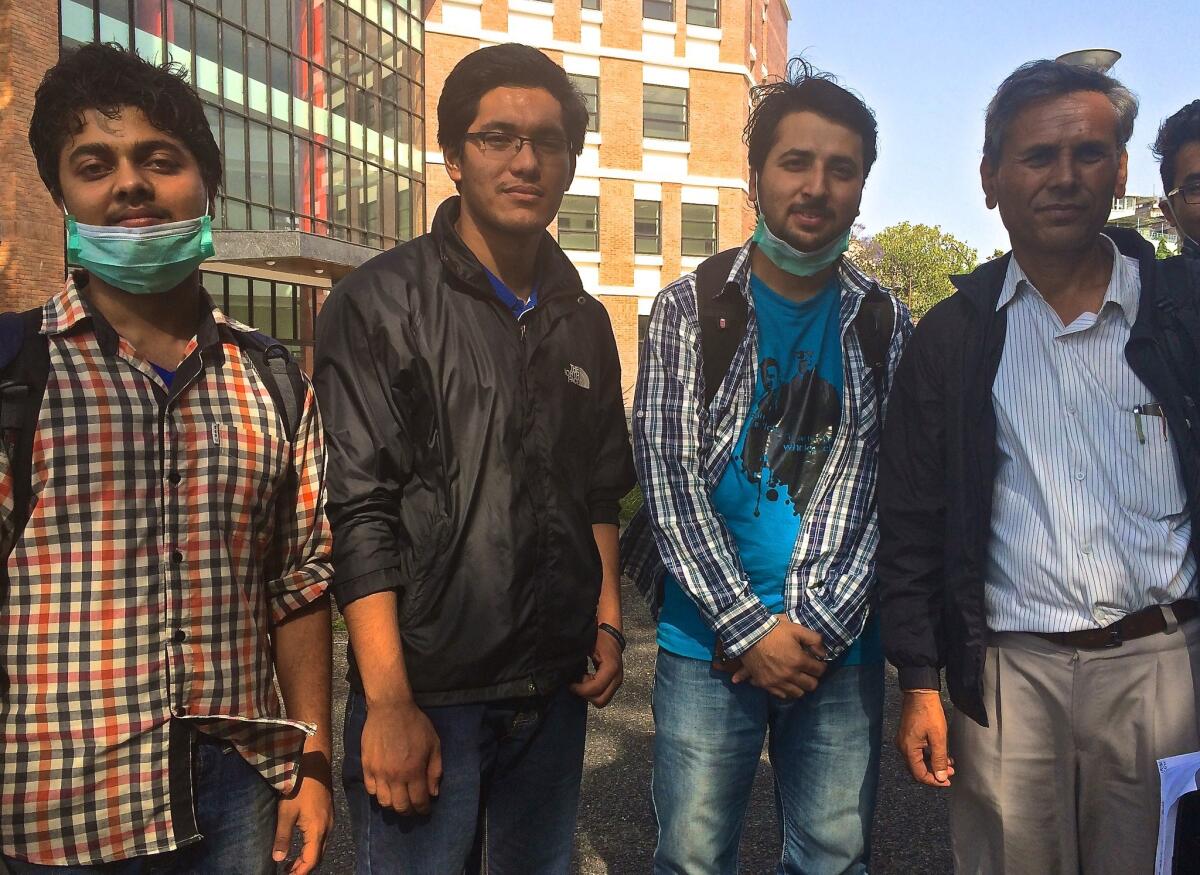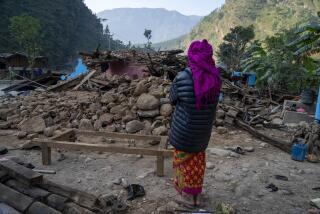Nepal drafts students for crash course in inspecting quake-damaged buildings

- Share via
Reporting from Katmandu, Nepal — The group of about 10 young building-inspectors-to-be tromped across the campus of Tribhuvan University’s engineering school Friday, listening to tips from their professors about how to assess whether a building cracked by Nepal’s giant earthquake was safe.
The fresh-faced college students, most of them undergraduates, learned how to identify whether cracks were caused by tension or compression, and how to categorize them by size – minor (5 millimeters or less), medium or major (big enough to put a finger into).
“Tension is worse; it means the framework of the building is not working,” Aakash Parajuli, a 22-year-old civil engineering student, said after touring, with teachers, the heavily damaged century-old main administration building and the superficially affected Department of Architecture and Urban Planning. “We are just learning, and then they will mobilize us.”
The magnitude 7.8 temblor that shook Nepal on April 25 destroyed at least 130,000 homes and damaged 85,856, the government says, and 10,141 public buildings were destroyed and 13,502 damaged.
Now, a crucial task is letting citizens know whether it is safe to return to their damaged homes and workplaces, but the government lacks enough building inspectors to do the job.
That’s why students like Parajuli are being given a crash course in building inspection. About 500 have volunteered and will soon be dispatched to do “rapid visual assessments,” said Gokarna Bahadur Motra, a professor who is heading a task force to get the volunteers into the field.
The Nepal Engineering Assn. and the National Society for Earthquake Technology are also participating in the effort.
A week after the quake, about 24,000 people are camped out at 13 sites in Katmandu alone, with three more camps still to be assessed.
“If we can assure people it is safe to return to their homes, this will lessen some of the burden on aid efforts,” Motra said. “Our main task right now is to evaluate buildings, say whether it’s safe to go back inside, and encourage people to go back to those that are safe.”
Padam Kumar Mainali, a spokesman at the Ministry of Urban Development, said Friday that a team lead by government authorities has assessed the damage at the prime minister’s office and the Supreme Court and will soon be looking at other government buildings.
Madhav Koirala, president of the Nepal Engineers Assn., told the Himalayan Times that inspectors will use a three-colored system much like that in California. Red will be used to identify houses unfit for living. Yellow will signify those structures that will be suitable after undergoing repairs, or are partially habitable. Green will mean fit for use without any repairs.
The government has established a national reconstruction fund, initially allocating about $200 million, but aiming to raise that to $2 billion, about 10% of Nepal’s gross domestic product.
Authorities said the money would go toward resettling people rendered homeless by the disaster, construction of low-cost houses, and reconstruction of government buildings. The state also said it would provide about $250 to each household that requires only minor repairs to its home.
Absent a detailed survey, Motra estimated that about 5% of damaged buildings in Katmandu would need to be torn down and that 40% to 45% would need significant repairs. Half, he surmised, sustained only minor cracking.
Though the job remains enormous, several members of Motra’s task force said they were surprised that the damage wasn’t more extensive, considering how powerful the quake was.
“We were actually expecting much more serious devastation,” said Surya Raj Acharya, a visiting professor at Tribhuvan University’s Department of Civil Engineering. “We have a lot to learn from this experience, and we should share that knowledge internationally, with the U.S., Japan and Europe.”
Motra, who received his doctorate in earthquake engineering from the Indian Institute of Technology in Mumbai, said he believed that the construction of high-rise buildings in Katmandu in the last eight to nine years saved lives.
Previously, such tall structures were not permitted in the capital. The new structures, which required professional engineering with government approval, replaced many old buildings.
“With these apartments, lives have been saved,” Motra said.
Still, Nepal has had building codes for only about 20 years, and has really started enforcing them just in the last 10 to 15 years in urban areas, Motra said. Buildings of up to three stories with less than 12 to 13 feet between walls or pillars are still subject only to what he called the “thumb rules” of design.
Nagendra Raj Sitoula, coordinator of the disaster risk management program at Tribhuvan University, said it was only in 2014 that all municipalities were bound to enforce building codes. And even so, 80% of Nepalese citizens live in rural areas not subject to such rules.
The extensive repair and reconstruction work ahead should mean a good job market for engineering students like Anuj Pradhananga.
On April 25, students in his department were about to sit down for exams when the ground began to rumble. The tests were canceled, and classes have been called off for the next 15 days.
In the meantime, the students are getting some hastily arranged practicum.
“All the neighbors are asking me, ‘Is my house safe?’” Pradhananga said. “We don’t have the knowledge. That’s why we are here following the teachers now.”
Follow @JulieMakLAT for news from Nepal’s earthquake.
More to Read
Sign up for Essential California
The most important California stories and recommendations in your inbox every morning.
You may occasionally receive promotional content from the Los Angeles Times.










